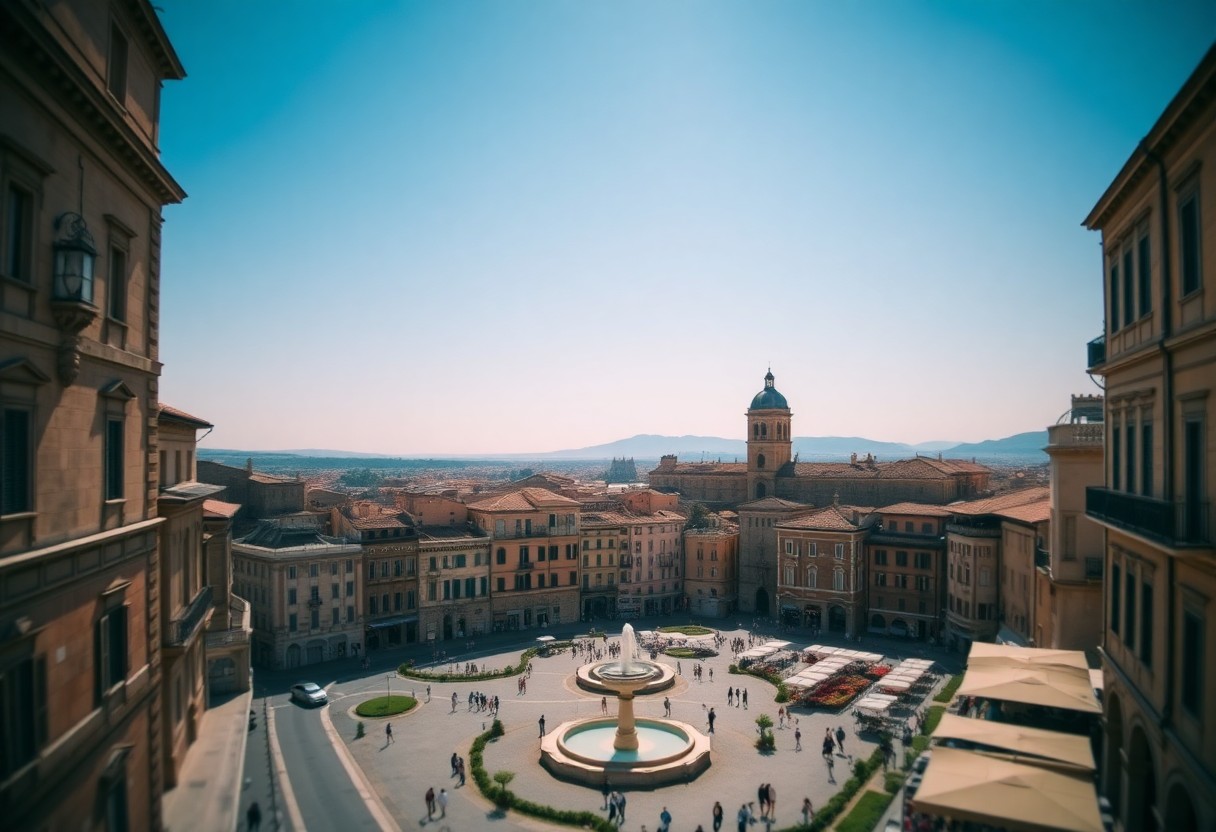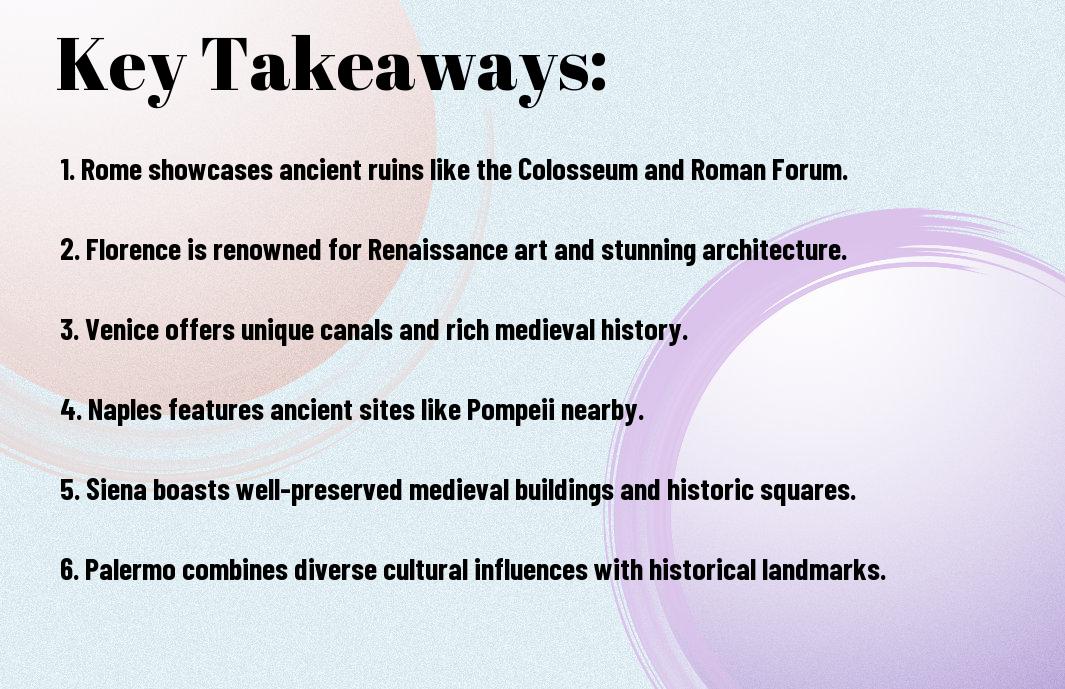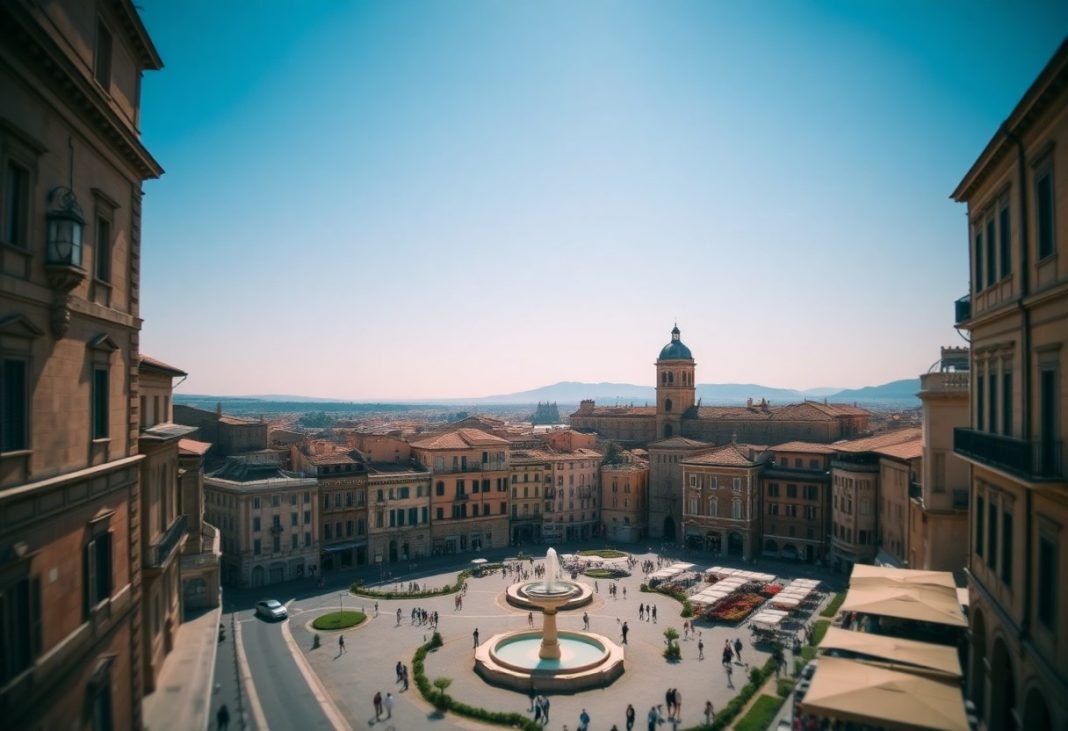History surrounds you as you explore Italy, a country where ancient ruins, medieval streets, and Renaissance art await at every turn. If you have a passion for discovering the past, these 25 cities offer an unparalleled journey through time, allowing your curiosity to thrive. From iconic landmarks to hidden gems, you’ll find rich stories embedded in their architecture and culture. Whether you’re a seasoned traveler or a casual explorer, your love for history will be deeply fulfilled in these remarkable Italian destinations.
Key Takeaways:
- Italy offers a diverse range of cities rich in historical significance, each showcasing unique architectural styles and cultural heritages from different periods.
- Visitors can explore well-preserved ancient ruins, medieval towns, Renaissance art centers, and vibrant local traditions that highlight Italy’s multifaceted history.
- These cities provide immersive experiences for history enthusiasts, combining educational opportunities with picturesque landscapes and authentic Italian culture.
Rome: The Eternal City
Before you research into Italy’s rich historical tapestry, Rome stands as a timeless gateway. This city, known as the Eternal City, offers you unparalleled access to millennia of culture, art, and architecture. Walking through its streets, you are surrounded by stories from different eras, waiting to be discovered. As your journey unfolds, Rome reveals itself not only as a capital city but as a living museum where every corner invites you to explore and connect with the past.
Ancient Landmarks
Ancient Rome’s grandeur is evident through its iconic landmarks, which you can explore to grasp the city’s historical depth. Sites like the Colosseum, Roman Forum, and Pantheon showcase engineering marvels and public spaces that once defined Roman civilization. Visiting these sites allows you to envision the daily life of ancient Romans and appreciate their contributions to law, architecture, and society, all preserved impressively for your discovery.
Vatican City Exploration
An exploration of Vatican City offers you a unique opportunity to probe religious history and artistic heritage. As the smallest independent state in the world, it houses priceless treasures, including St. Peter’s Basilica and the Sistine Chapel. Your visit here not only enhances your historical knowledge but also connects you with the spiritual heart of Catholicism through breathtaking art and architecture.
In fact, when you explore Vatican City, you gain insight into its pivotal role in shaping Western culture and religion. Beyond its religious significance, the Vatican Museums contain an extensive collection of art gathered over centuries, providing you with a comprehensive understanding of human artistic achievement. As you wander through these halls, the blend of spiritual devotion and artistic genius comes alive, making your visit an enriching experience that extends well beyond mere sightseeing.
Florence: The Cradle of the Renaissance
If you have a passion for history and art, Florence offers an unparalleled experience. This city is celebrated worldwide for its remarkable role in the Renaissance, where art, culture, and intellect blossomed like nowhere else. By wandering through its streets and visiting its museums, you will immerse yourself in centuries of creativity that shaped modern Western civilization. Florence invites you to explore masterpieces and historic landmarks that resonate with the passion and innovation of genius minds.
Artistic Masterpieces
Between the walls of Florence’s museums and churches, you will find some of the most iconic works of art ever created. The Uffizi Gallery presents paintings by Botticelli and Leonardo da Vinci, while the Accademia Gallery houses Michelangelo’s David. Each piece reveals the profound skill and vision that defined the Renaissance period. Your visit here will deepen your appreciation for artistic expression and the evolution of creativity throughout history.
Historical Significance
Behind Florence’s stunning art lies a history of influence and innovation. As the birthplace of the Renaissance, it was home to powerful patrons like the Medici family, who supported artists and scholars alike. You can trace the development of humanism, scientific inquiry, and cultural advancement, all of which fundamentally altered Europe’s trajectory. Exploring Florence offers you insight into how history and art intertwine to shape society.
With its well-preserved architecture and rich archives, Florence serves as a living chronicle of Renaissance ideals. Walking through its palaces and plazas, you witness the legacy of visionaries who championed education, politics, and the arts. Your journey through the city’s historical landmarks reveals Florence as a beacon of progress during a pivotal era, making it an vital destination for those dedicated to understanding history’s impact on the present.

Venice: A City of Canals and History
Not many cities in the world can rival Venice when it comes to its unique blend of waterway charm and rich history. As you explore its labyrinth of canals, you’ll uncover stories dating back centuries, with every bridge and narrow street whispering tales from the past. Venice invites you to experience a living museum where history and culture flow alongside the gentle waves beneath your feet.
Architectural Wonders
About Venice’s architectural wonders, you can admire a stunning array of Gothic, Renaissance, and Baroque buildings. The city’s iconic palaces and churches showcase intricate craftsmanship and designs that have stood the test of time. As you wander through Venice, you’ll find that architecture here is not just about structures—it’s a testament to the city’s enduring legacy and artistic spirit.
The Doge’s Palace
About The Doge’s Palace, you will discover an emblem of Venetian power and governance. This majestic building served as the residence of the Doge, the supreme authority of the former Venetian Republic. When you step inside, you experience the grandeur of lavish halls, exquisite frescoes, and a rich collection of art that reveals the city’s political and artistic prowess.
City history unfolds vividly within The Doge’s Palace, offering you access to hidden chambers, ancient courtrooms, and the famous Bridge of Sighs, linking you directly to Venice’s political intrigue and judicial history. Touring this magnificent palace deepens your appreciation for Venetian governance and the city’s remarkable role in shaping European history.
Milan: The Fashion Capital with a Rich Past
Despite being globally renowned as the fashion capital, Milan offers much more for those who cherish history. When you explore this vibrant city, you discover layers of historical significance intertwined with its modern flair. From Roman ruins beneath the bustling streets to medieval castles and Renaissance art, Milan invites you to explore into a past that enriches your experience far beyond shopping districts and runways.
Historical Sites
Above all, Milan boasts impressive historical sites that captivate your interest. You can visit the iconic Duomo di Milano, a Gothic masterpiece that took centuries to complete, or explore the ancient Roman Theater and the remnants of city walls that speak to Milan’s long-standing heritage. These sites provide a tangible connection to the past, making Milan a unique destination for history enthusiasts like you.
Cultural Influences
On your journey through Milan, you encounter a confluence of cultural influences that have shaped the city’s identity. The blend of Roman origins, medieval tradition, and Renaissance artistry reveals itself in every corner, from architecture to cuisine. These layers of culture enrich your understanding of Milan, offering a multifaceted perspective on its evolution through time.
Another aspect to consider is Milan’s role in the arts and intellectual movements. As a hub during the Renaissance, Milan attracted artists like Leonardo da Vinci, whose works still adorn the city. You also experience the impact of numerous historical epochs reflected in the city’s museums and galleries, providing insight into a dynamic cultural heritage that enhances your visit.
Naples: A Blend of History and Culinary Delight
Many travelers find Naples irresistible for its rich historical tapestry combined with world-renowned cuisine. As you stroll through its vibrant streets, you’ll discover ancient architecture, bustling markets, and a food culture that reflects centuries of tradition. Naples offers more than just a visit—it invites you into a living museum where history and flavor blend seamlessly, making it a must-visit destination for any history enthusiast with a passion for authentic Italian gastronomy.
Archaeological Treasures
About a short distance from Naples, you can explore remarkable archaeological sites that reveal the city’s ancient roots. You’ll find artifacts and ruins that tell stories of Greek and Roman civilizations, including underground catacombs and historical museums. These treasures offer you a unique glimpse into the daily lives and cultures that shaped this historic metropolis over millennia.
The Legacy of Pompeii
An unforgettable experience awaits you at Pompeii, where history has been preserved under volcanic ash for centuries. Exploring this ancient city allows you to walk through streets frozen in time, witnessing the remarkably intact architecture, frescoes, and artifacts that speak directly to the lives and tragedies of its former residents.
This extraordinary preservation lets you more deeply understand Roman urban life, from public baths and theaters to private homes. As you navigate Pompeii’s ruins, you see history not just in textbooks but in the tangible remains that bring the past vividly to life, creating a powerful connection between you and the ancient world.
Bologna: The University City
Your visit to Bologna immerses you in a city renowned for its rich academic and culinary traditions. Known as the home of the oldest university in the Western world, Bologna offers a unique blend of medieval architecture and vibrant student life. As you stroll through its ancient streets, you experience an environment where history and education intertwine, making it a perfect destination for those who appreciate historical depth combined with cultural vibrancy.
Academic Heritage
One of Bologna’s defining features is its prestigious university, established in 1088. When you explore the university’s historic buildings, you witness centuries of scholarly pursuit that have shaped European intellectual history. Your journey through lecture halls, ancient libraries, and museums connects you directly to the legacy of renowned thinkers who studied and taught here.
Culinary History
Above all, Bologna delights your senses with its legendary culinary heritage. Known as the gastronomic capital of Italy, the city invites you to discover traditional dishes such as tagliatelle al ragù and mortadella. The food culture here is a testament to the region’s agricultural wealth and centuries-old cooking practices.
History of Bologna’s cuisine dates back to medieval times, reflecting the melding of diverse influences from surrounding regions. When you taste its iconic recipes, you’re experiencing a tradition perfected over generations, rich with flavors that tell the story of the city’s social and economic development. Your palate becomes a gateway to understanding the deeper cultural narrative of Emilia-Romagna.

Summing up
Hence, exploring the 25 best cities in Italy offers you a unique journey through time, allowing you to immerse yourself in rich historical narratives and architectural marvels. Whether you seek ancient ruins, Renaissance art, or medieval charm, these cities provide diverse experiences that cater directly to your passion for history. By visiting these destinations, you will not only deepen your understanding of Italy’s cultural heritage but also create unforgettable memories that bring the past vividly to life right before your eyes.
Q: Which Italian cities are most recommended for exploring ancient Roman history?
A: For ancient Roman history enthusiasts, Rome is the top destination with landmarks like the Colosseum, Roman Forum, and Palatine Hill. Additionally, cities such as Pompeii and Ostia Antica offer well-preserved ruins that provide immersive experiences of daily life during the Roman Empire.
Q: What makes Florence an important city for lovers of Renaissance history?
A: Florence stands out as the birthplace of the Renaissance, boasting incredible art, architecture, and history from that period. Visitors can explore masterpieces in the Uffizi Gallery, admire the stunning Florence Cathedral (Duomo), and stroll through historic streets that were frequented by artists like Michelangelo and Leonardo da Vinci.
Q: Are there any lesser-known Italian cities that hold rich historical significance?
A: Yes, beyond the famous cities, places like Lecce in the Apulia region offer unique Baroque architecture, and Matera in Basilicata features ancient cave dwellings called “Sassi,” which date back thousands of years. These cities provide fascinating insights into different eras of Italian history without the heavy tourist crowds found in more popular destinati





